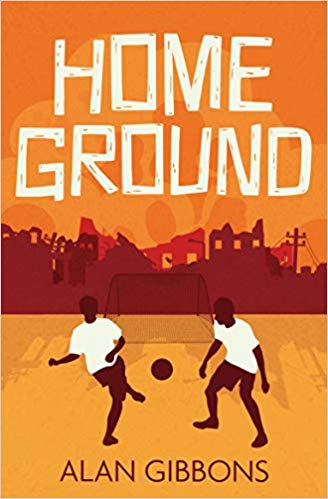Inspiring Young Readers
 posted on 28 Apr 2019
posted on 28 Apr 2019
Home Ground by Alan Gibbons
Sam fervently believes that his football team, West Park Celtic can start winning games, but it seems doomed to be stuck at the bottom of the league unless the players can get their act together. Their manager is always encouragingly upbeat but he is becoming frustrated at their lack of team spirit and the tension between Sam and the team captain Jordan doesn’t help. Jordan likes to be at the centre of the action and doesn’t take kindly to any criticism about his tactics.
For some time, Sam has been aware of a boy watching the team play from the side lines. When they eventually speak, he learns that the boy’s name is Hasan and that he is an Iraqi refugee. It seems that he and his friend Faisal play in a mixed age refugee team but would be keen to try out for West Park Celtic. When they do, it is obvious that they are both talented footballers. It is no surprise to learn that Jordan is unhappy about this, particularly when Faisal turns out to be very skilful and could be a huge asset to the team:
‘He was taller and stronger than Hasan. He didn’t do as many tricks but had such close control, nobody could get the ball off him. He scored twice with his feet and once with his head’.
It really seems as if the new players might be able to change the fortunes of the team and most of the boys are thrilled to almost win a match. Everything seems set for victory when they meet for their next game against Yew Tree Juniors. But where is Faisal? Can they possibly win without his help? Why does Jordan look so happy when he doesn’t show up? Without going into details, Jordan quickly proves himself to be an all-round nasty piece of work with questionable attitudes that are not shared by Sam and the rest of the team.
At the end of each chapter, this award winning author includes some factual information to provide context for the story. This is a successful formula that we’ve seen before in The Beautiful Game, which is one of three other football themed stories which cleverly weave fact with fiction. This time the reader learns that ‘refugees are ordinary people like you and me’, why they are forced to flee their countries of origin, the reasons why a tiny percentage might come to settle in the UK and how they contribute positively to society. There are also facts about the ways in which football continues to be used as a way of educating people about refugee issues by organisations like Amnesty International and interesting background about some real refugee football stars like Fabrice Muamba.
As ever, the publisher Barrington Stoke has paid close attention to the aesthetics of the format to ensure that it appeals to emergent, reluctant and dyslexic readers aged 8 and above. I liked the atmospheric cover design that shows two boys confidently kicking a ball against a war torn city backdrop. The black and white illustrations by Chris Chalik that appear throughout the story provide a glimpse into the pace of the game as well as helping to emphasise some tense moments.
Alan Gibbons is renowned for writing novels with pace and depth and this one is packed with plenty of detailed football match action. I am no great football fan but need to congratulate him because even I could picture what was happening and felt fully engaged! Most of all, I love the enthusiasm of these young boys which spills across the pages and keeps them motivated. As such, it will definitely appeal to avid football fans, but it is a story that emphasises the need for solidarity against the odds, the strength of community and the benefits of friendship and loyalty in countering hatred. I can only hope that it is read more widely because it distils so many important political messages. The universal language of sport is often described as helping to contribute to an understanding of differences between people from a range of backgrounds. I will certainly be using it with children and students and recommending it as a well told story that encourages empathy for refugees.
Karen Argent
April 2019